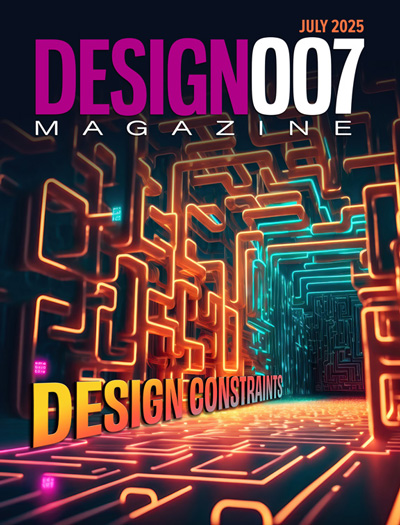-

- News
- Books
Featured Books
- design007 Magazine
Latest Issues
Current Issue
Signal Integrity
If you don’t have signal integrity problems now, you will eventually. This month, our expert contributors share a variety of SI techniques that can help designers avoid ground bounce, crosstalk, parasitic issues, and much more.

Proper Floor Planning
Floor planning decisions can make or break performance, manufacturability, and timelines. This month’s contributors weigh in with their best practices for proper floor planning and specific strategies to get it right.

Showing Some Constraint
A strong design constraint strategy carefully balances a wide range of electrical and manufacturing trade-offs. This month, we explore the key requirements, common challenges, and best practices behind building an effective constraint strategy.
- Articles
- Columns
- Links
- Media kit
||| MENU - design007 Magazine
Beyond Design: How to Handle the Dreaded Danglers, Part 2
October 12, 2016 | Barry Olney, In-Circuit Design Pty LtdEstimated reading time: 2 minutes
In Part 1 of this series, I deliberated on how dangling via stubs distort signals passing through an interconnect and also decrease the usable bandwidth of the signal. This is due to the via stub acting as a transmission line antenna, which has a resonant frequency determined by the quarter wavelength of the structure. The conventional solution to this problem is to back-drill (or control depth drill) the vias to bore out the via stub barrels, so that the via stubs are reduced in length if not completely removed. This month I will look into all the possible solutions to alleviate this issue.
1. Back-drill the stub
Back-drilling is a process to remove the stub portion of a plated through-hole (PTH) via. It is a post-fabrication drilling process where the back-drilled hole is of larger diameter than the original PTH. This technology is often used instead of blind via technology to remove the stubs of connector vias in very thick high-speed backplane designs. State-of-the-art board fabrication shops are able to back-drill to within 8 mils of the signal layer, so there will always be a small stub portion attached to the via.
High-speed, SERDES, serial link-based backplanes generally have thick substrates. This is due to the system architecture and backplane to card interconnect requirements such as press-fit connectors. Back-drilling the via stub is a common practice, on thick PCBs, to minimize stub length for bit-rates greater than 3Gbps (1.5GHz). However, at transmission rates >10Gbps (5GHz), back-drilling alone may not be adequate to reduce jitter and bit error rate (BER).
Figure 1 shows the effects of excessively long via stubs on a high-speed differential pair. On the left, the differential pair is simulated using a pseudo random bit stream (PRBS) with lossy transmission lines enabled; note the open eye pattern. However, on the right, I had included via modelling, which enables the via parasitics and highlights the effects of via resonance. The high-frequency harmonics are attenuated, rolling off the signal rise time, distorting the signal, reducing bandwidth and closing the eye.
Vias can appear as capacitive and/or inductive discontinuities. These parasitics contribute to the degradation of the signal as it passes through the via. At high frequencies and with thick backplane substrates, it is imperative that these issues are addressed.
Back-drilling typically requires specialized equipment, and further requires that the back-drill be precisely located over the vias. As such, the back-drilling process, especially two sided back-drilling, is expensive due to drill breakage and yield issues and is very time-consuming.
To read this entire article, which appeared in the September 2016 issue of The PCB Design Magazine, click here.
Testimonial
"Our marketing partnership with I-Connect007 is already delivering. Just a day after our press release went live, we received a direct inquiry about our updated products!"
Rachael Temple - AlltematedSuggested Items
New Podcast Episode Drop: MKS’ Atotech’s Role in Optimize the Interconnect
09/08/2025 | I-Connect007In this episode of On the Line With…, host Nolan Johnson sits down with Patrick Brooks, MKS' Atotech's Global Product Director, EL Systems, to discuss the critical role that wet processes play alongside laser systems in advancing the Optimize the InterconnectSM initiative. Brooks points to Bondfilm as a key example—a specialized coating that enables CO₂ lasers to ablate more effectively than ever before.
New Episode Drop: MKS’ ESI’s Role in Optimize the Interconnect
08/26/2025 | I-Connect007In this latest episode, Casey Kruger, director of product marketing at MKS’ ESI, joins On the Line With… host Nolan Johnson to share how CO₂ laser technology delivers faster, more accurate vias in a smaller, more energy-efficient footprint.
New Podcast Episode Drop: Optimize the Interconnect and the Future of HDI
07/28/2025 | I-Connect007The Optimize the Interconnect podcast series continues with its second installment, featuring Chris Ryder, senior director of business development at MKS’ ESI. In this episode, Ryder shares compelling real-world examples that illustrate why Optimize the Interconnect is gaining traction across the industry.
New Podcast Series Launches: Optimize the Interconnect
07/16/2025 | I-Connect007I-Connect007 is excited to announce the debut of Optimize the Interconnect—a new podcast series featuring guest Chris Ryder, senior director of business development at MKS’ ESI. This insightful series explores how MKS’ ESI is rethinking microvia formation for today’s most advanced HDI PCB and substrate designs.
Trouble in Your Tank: Can You Drill the Perfect Hole?
07/07/2025 | Michael Carano -- Column: Trouble in Your TankIn the movie “Friday Night Lights,” the head football coach (played by Billy Bob Thornton) addresses his high school football team on a hot day in August in West Texas. He asks his players one question: “Can you be perfect?” That is an interesting question, in football and the printed circuit board fabrication world, where being perfect is somewhat elusive. When it comes to mechanical drilling and via formation, can you drill the perfect hole time after time?


